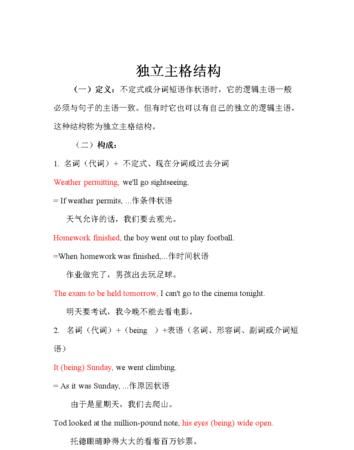本文目录
英语独立主格结构是什么
(一):独立主格的概念
“独立主格结构”是由名词或代词作为逻辑主语,加上分词、形容词、副词、动词不定式或介词短语作为逻辑谓语构成。这种结构在形式上与主句没有关系,通常称为“独立主格结构”。
(二):独立主格的功能
“独立主格结构”实质就是带有自己主语的非限定状语从句。众所周知非限定性从句通常以主句的某一成分作为自己的逻辑主语,从而依附于主句。而有些非限定性从句和无动词从句带有自己的主语,在结构上与主句不发生关系,因此成为独立主格结构。其实,虽然叫做独立主格结构,并不是真正的独立,它还是一种从属分句,在句中有多种作用。如:表原因、表条件、表方式、表伴随、表时间等,在句中通常起状语作用。
独立主格结构主要用于描绘性文字中,其作用相当于一个状语从句,常用来表示时间、原因、条件、行为方式或伴随情况等。例如:
1) 表示时间
The meeting being over, all of us went home. 开完会后我们都回家了。
Her work done, she sat down for a cup of tea. 她干完了活,坐下来喝茶。
2) 表示条件
The condition being favourable, he may succeed. 若条件有利,他或许能成功。
3) 表示原因
There being no taxis, we had to walk. 没有出租车,我们只好步行。
He wrapped her up with great care, the night being dark and frosty. 夜又黑又冷,所以他把她裹得严严实实的。
4) 表示伴随情况
Almost all metals are good conductors, silver being the best of all. 几乎所有的金属都是良导体,而银则是最好的导体。(=Almost all metals are good conductors,
and silver is the best of all.)
(三): 独立主格结构的构成:
名词(代词)+现在分词、过去分词;
名词(代词)+形容词;
名词(代词)+副词;
名词(代词)+名词
名词(代词)+不定式;
名词(代词) +介词短语构成。
(四) 独立主格结构的特点:
(1)独立主格结构的逻辑主语与句子的主语不同,它独立存在。
2)名词或代词与后面的分词,形容词,副词,不定式,介词等是主谓关系。
3)独立主格结构一般有逗号与主句分开。
举例:(一)
1) 名词/代词+形容词
The men moved slowly forward, neck deep in the water, with their officers guiding them.
It stood silent in the noon sunlight, its door open.
2) 名词/代词+现在分词
Winter coming, it gets colder and colder. 冬天来了,天气越来越冷了。
The rain having stopped, he went out for a walk. 雨停了,他出去散步。
The question being settled, we wound up the meeting. 问题解决之后,我们结束了会议。
3) 名词/代词+过去分词
“Marquis,” said the boy, turning to the man, his eyes opened wide, and his right hand raised.
4) 名词/代词(主格)+不定式
We shall assemble at ten forty-five, the procession to start moving at precisely eleven. 我们十点四十五分集合,队伍十一点准时出发。
Here are the first two volumes, the third one to come out next month. 这是前两卷,第三卷将于下月问世。
We divided the work, he to clean the windows and I to sweep the floor. 我们进行了分工,他擦窗户,我扫地。
The two boys said good-bye to each other, one to go home, the other to go to his friend’s. 两个男孩彼此道了别,一个回了家,另一个去了他朋友家。
5) 名词/代词+介词短语
I followed him here, climbed in, sword in hand.
The huntsman entered the forest, gun in hand. 那位猎人手里提着枪走进了树林。
He sat at the table, coat off, head down, and pen in hand.
6) 名词/代词+副词
Nobody in, the thief took a lot of things away.
Lunch over, he left the house. But he was thinking.
7) 名词/代词+名词
he fought the wolf, a stick his only weapon. 他和狼搏斗着,唯一的武器是一根棍棒。

英语中什么叫独立主格结构
独立主格,首先它是一个“格”,而不是一个“句子”,在英语中任何一个句子都要有主谓结构,而在这个结构中,没有真正的主语和谓语动词,但又在逻辑上构成主谓或主表关系,因而成为考试尤其选择题中的一个难点。
“独立主格结构”是由名词或代词作为逻辑主语,加上分词、形容词、副词、动词不定式或介词短语作为逻辑谓语构成。这种结构在形式上与主句没有关系,通常称为“独立主格结构”。
独立主格在实际应用中并不多见,主要出现文献中。一般外国人也不是很了解这一结构,但真的碰到了他肯定能看得懂,就像咱们如果对他毫无语法规则可言但词汇用得八九不离十地说些什么他也听得懂。语法就是人的语言思维在运行过程中产生的逻辑进行整理而成的产物,是根据人们认识事物的逻辑顺序来的,从这一点上说所谓的西文思维和汉藏语思维没什么差别,因此只要通过某些例句找到语感,一些与中文思维相去甚远的句子就也都能够记住并使用了。

英语中什么是独立主格结构
简单来说就是,一个句子有主语有谓语,比如I do,I是主语,do是谓语。而独立主格结构就是把谓语动词弄成非谓语动词态(主要是加-ing),如上句成I doing。这样就可以把它当成一个状语(形容词)等,以简化句子。

英语独立主格结构是什么意思
独立主格结构(Absolute Construction)由两部分组成,前一部分是名词或者代词,后一部分是非谓语动词(不定式、现在分词、过去分词)或形容词、副词、名词或介词短语。前后两部分具有逻辑主谓关系。
在英语中,动词按作用和功能主要分为两大类,一类是谓语动词,另一类是非谓语动词。独立主格结构在句中作状语,多用于书面语。 独立主格结构本身不是句子,在句子中作状语,表时间、原因、条件、伴随、目的及状态等。

扩展资料:
用法:
独立主格结构主要表示谓语动词发生的时间、原因、条件或伴随情况等,相当于一个状语从句或并列句。
【1】用作时间状语
The work done(=After the work had been done), we went home. 工作完成后,我们就回家了。
【2】用作条件状语
Weather permitting(=If weather permits), they will go on an outing to the beach tomorrow. 如果天气允许的话,他们将在明天组织一次海滨小游。
【3】用作原因状语
An important lecture to be given tomorrow(=As an important lecture will be given tomorrow), the professor has to stay up late into the night. 因为明天要发表一个重要的演讲,教授不得不熬夜到很晚。
【4】用作伴随状语
He was lying on the grass,his hands crossed under his head(=and his hands were crossed under his head).他躺在草地上,将两手交叉枕在脑后。
【5】用作补充说明
We redoubled our efforts,each man working like two. 我们加倍努力,一个人干两个人的活。
*注:独立主格结构表示时间、条件或原因时,相当于一个状语从句,一般放在句首,表示原因时还可放在句末;表伴随状况或补充说明时,相当于一个并列句,通常放于句末。
参考资料:百度百科-独立主格结构
以上就是关于英语中的独立主格结构是什么意思,英语独立主格结构是什么的全部内容,以及英语中的独立主格结构是什么意思 的相关内容,希望能够帮到您。

